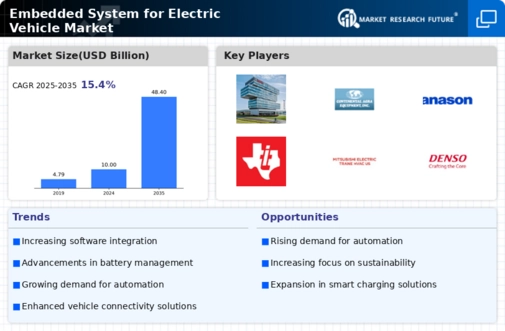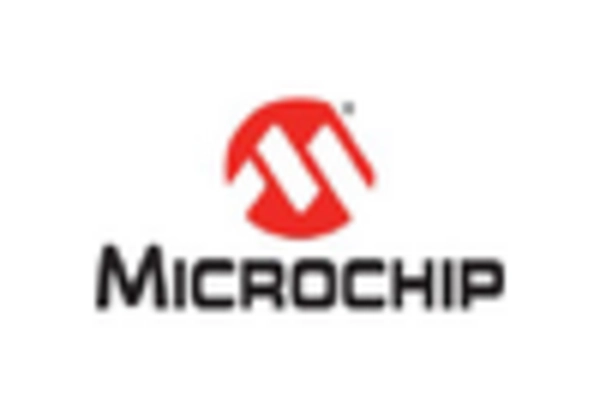-
Definition
-
Scope of Study
-
Research Objective
-
Assumptions & Limitations
-
Market Structure: 2 Research Componentsology
-
Research Process
-
Primary Research
-
Secondary Research 3 Market Dynamics
-
Drivers
-
Restraints
-
Opportunities
-
Challenges
-
Macroeconomic Indicators 4 Market Factor Analysis
-
Porter’s five forces model
- Bargaining Power of suppliers
- Bargaining Power of Customer
- Intensity of Competitor’s
- Threat of New Entrants 5 Embedded System for Electric Vehicle, By Component
-
Introduction
- Sensors
- MCU
- Transceivers
- Memory Devices 6 Embedded System for Electric Vehicle, By Application
-
Introduction
- Infotainment & Telematics
- Body Electronics
- Safety & Security 7 Embedded System for Electric Vehicle, By Region
-
Introduction
- North America
- Europe
- Asia Pacific
- Middle East & Africa 8 Company Landscape
-
Introduction
- Mergers Acquisitions
- Collaborations
- Release/New Product Launches
- Other (Expansion, Updates, Partnership) 9 Company Profile
-
Robert Bosch
- Company Overview
- Product/Business Segment Overview
- Financials
- Key Developments
-
Continental AG
- Overview
- Product/Business Segment Overview
- Financials
- Key Developments
-
Panasonic
- Overview
- Product/Business Segment Overview
- Financials
- Key Developments
-
Texas Instruments
- Overview
- Product/Business Segment Overview
- Financials
- Key Developments
-
Mitsubishi Electric
- Overview
- Product/Business Segment Overview
- Financials
- Key Developments
-
DENSO
- Overview
- Product/Business Segment Overview
- Financials
- Key Developments
-
Delphi
- Overview
- Product/Business Segment Overview
- Financials
- Key Developments
-
Appendix List of Tables
-
EUROPE EMBEDDED SYSTEM FOR ELECTRIC VEHICLE, BY REGION 2024-2032, ($ MILLION) 19
-
EUROPE EMBEDDED SYSTEM FOR ELECTRIC VEHICLE FOR SENSORS, BY REGION 2024-2032, (MILLION) 19
-
EUROPE EMBEDDED SYSTEM FOR ELECTRIC VEHICLE FOR MCU, BY REGION 2024-2032, (MILLION) 20
-
EUROPE EMBEDDED SYSTEM FOR ELECTRIC VEHICLE FOR TRANSRECIEVER, BY REGION 2024-2032, (MILLION) 20
-
EUROPE EMBEDDED SYSTEM FOR ELECTRIC VEHICLE FOR MEMORY DEVICE, BY REGION 2024-2032, (MILLION) 20
-
EUROPE EMBEDDED SYSTEM FOR ELECTRIC VEHICLE FOR INFOTAINMENT & TELEMATICS, BY REGION 2024-2032, (MILLION) 21
-
EUROPE EMBEDDED SYSTEM FOR ELECTRIC VEHICLE FOR BODY ELECTRONICS, BY REGION 2024-2032, (MILLION) 21
-
EUROPE EMBEDDED SYSTEM FOR ELECTRIC VEHICLE FOR SAFETY & SECURITY, BY REGION 2024-2032, (MILLION) 21
-
EUROPE EMBEDDED SYSTEM FOR ELECTRIC VEHICLE, BYAPPLICATION 2024-2032, (MILLION) 22
-
EUROPE EMBEDDED SYSTEM FOR ELECTRIC VEHICLE, BYAPPLICATION 2024-2032, (MILLION) 22
-
MIDDLE EAST EMBEDDED SYSTEM FOR ELECTRIC VEHICLE, BYAPPLICATION 2024-2032, (MILLION) 23
-
AFRICA EMBEDDED SYSTEM FOR ELECTRIC VEHICLE, BYAPPLICATION, 2024-2032, (MILLION) 23
-
EUROPE EMBEDDED SYSTEM FOR ELECTRIC VEHICLE 2024-2032, ($MILLION) 24
-
EUROPE EMBEDDED SYSTEM FOR ELECTRIC VEHICLE, BY COUNTRY 2024-2032, ($MILLION) 25
-
GERMANY EMBEDDED SYSTEM FOR ELECTRIC VEHICLE, BY COMPONENTS 2024-2032, ($MILLION) 25
-
GERMANY EMBEDDED SYSTEM FOR ELECTRIC VEHICLE, BYAPPLICATION 2024-2032, ($MILLION) 26
-
FRANCE EMBEDDED SYSTEM FOR ELECTRIC VEHICLE, BY COMPONENTS 2024-2032, ($MILLION) 26
-
FRANCE EMBEDDED SYSTEM FOR ELECTRIC VEHICLE, BYAPPLICATION 2024-2032, ($MILLION) 26
-
ITALY EMBEDDED SYSTEM FOR ELECTRIC VEHICLE, BY COMPONENTS 2024-2032, ($MILLION) 27
-
ITALY EMBEDDED SYSTEM FOR ELECTRIC VEHICLE, BYAPPLICATION 2024-2032, ($MILLION) 27
-
SPAIN EMBEDDED SYSTEM FOR ELECTRIC VEHICLE, BY COMPONENTS 2024-2032, ($MILLION) 28
-
SPAIN EMBEDDED SYSTEM FOR ELECTRIC VEHICLE, BYAPPLICATION 2024-2032, ($MILLION) 28
-
U.K. EMBEDDED SYSTEM FOR ELECTRIC VEHICLE, BY COMPONENTS 2011-20127, ($MILLION) 29
-
U.K. EMBEDDED SYSTEM FOR ELECTRIC VEHICLE, BYAPPLICATION 2024-2032, ($MILLION) 29
-
SCANDINAVIA EMBEDDED SYSTEM FOR ELECTRIC VEHICLE, BY COMPONENTS 2024-2032, ($MILLION) 30
-
SCANDINAVIA EMBEDDED SYSTEM FOR ELECTRIC VEHICLE, BYAPPLICATION 2024-2032, ($MILLION) 30
-
BENELUX EMBEDDED SYSTEM FOR ELECTRIC VEHICLE, BY COMPONENTS 2024-2032, ($MILLION) 31
-
BENELUX EMBEDDED SYSTEM FOR ELECTRIC VEHICLE, BYAPPLICATION 2024-2032, ($MILLION) 31
-
REST OF EUROPE EMBEDDED SYSTEM FOR ELECTRIC VEHICLE, BY COMPONENTS 2024-2032, ($MILLION) 32
-
REST OF EUROPE EMBEDDED SYSTEM FOR ELECTRIC VEHICLE, BYAPPLICATION 2024-2032, ($MILLION) 32
-
MIDDLE EAST EMBEDDED SYSTEM FOR ELECTRIC VEHICLE, BY COUNTRY 2024-2032, ($MILLION) 33
-
SAUDI ARABIA EMBEDDED SYSTEM FOR ELECTRIC VEHICLE, BY COMPONENTS 2024-2032, ($MILLION) 34
-
SAUDI ARABIA EMBEDDED SYSTEM FOR ELECTRIC VEHICLE, BYAPPLICATION 2024-2032, ($MILLION) 34
-
UAE EMBEDDED SYSTEM FOR ELECTRIC VEHICLE, BY COMPONENTS 2024-2032, ($MILLION) 35
-
UAE EMBEDDED SYSTEM FOR ELECTRIC VEHICLE, BYAPPLICATION 2024-2032, ($MILLION) 35
-
KUWAIT EMBEDDED SYSTEM FOR ELECTRIC VEHICLE, BY COMPONENTS 2024-2032, ($MILLION) 36
-
KUWAIT EMBEDDED SYSTEM FOR ELECTRIC VEHICLE, BY COMPONENTS 2024-2032, ($MILLION) 36
-
QATAR EMBEDDED SYSTEM FOR ELECTRIC VEHICLE, BY COMPONENTS 2024-2032, ($MILLION) 37
-
QATAR EMBEDDED SYSTEM FOR ELECTRIC VEHICLE, BY COMPONENTS 2024-2032, ($MILLION) 37
-
REST OF MIDDLE EAST EMBEDDED SYSTEM FOR ELECTRIC VEHICLE, BY COMPONENTS 2024-2032, ($MILLION) 38
-
REST OF MIDDLE EAST EMBEDDED SYSTEM FOR ELECTRIC VEHICLE, BY COMPONENTS 2024-2032, ($MILLION) 38
-
AFRICA EMBEDDED SYSTEM FOR ELECTRIC VEHICLE, BY COUNTRY 2024-2032, ($MILLION) 39
-
SOUTH AFRICA EMBEDDED SYSTEM FOR ELECTRIC VEHICLE, BY COMPONENTS 2024-2032, ($MILLION) 40
-
SOUTH AFRICA EMBEDDED SYSTEM FOR ELECTRIC VEHICLE, BY COMPONENTS 2024-2032, ($MILLION) 40
-
NIGERIA EMBEDDED SYSTEM FOR ELECTRIC VEHICLE, BY COMPONENTS 2024-2032, ($MILLION) 41
-
NIGERIA EMBEDDED SYSTEM FOR ELECTRIC VEHICLE, BY COMPONENTS 2024-2032, ($MILLION) 41
-
ALGERIA EMBEDDED SYSTEM FOR ELECTRIC VEHICLE, BY COMPONENTS 2024-2032, ($MILLION) 42
-
ALGERIA EMBEDDED SYSTEM FOR ELECTRIC VEHICLE, BY COMPONENTS 2024-2032, ($MILLION) 42
-
REST OF AFRICA EMBEDDED SYSTEM FOR ELECTRIC VEHICLE, BY COMPONENTS 2024-2032, ($MILLION) 43
-
REST OF AFRICA EMBEDDED SYSTEM FOR ELECTRIC VEHICLE, BY COMPONENTS 2024-2032, ($MILLION) 43 List of Figures
-
Supply chain: Embedded Systems for Electric Vehicles 16
-
Porters five forces 17

















Leave a Comment